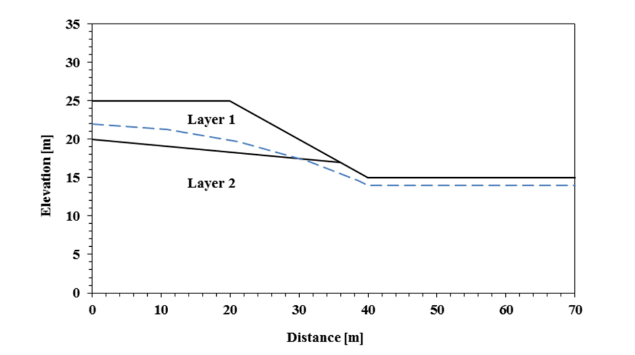The mobilized shear force defined in GD:bsShrFEq can be substituted into the definition of mobilized shear force based on the factor of safety, from GD:mobShr yielding Equation (1) below:
\[\left({\symbf{W}}_{i}-{\symbf{X}}_{i-1}+{\symbf{X}}_{i}+{\symbf{U}_{\text{g},i}} \cos\left({\symbf{β}}_{i}\right)+{\symbf{Q}}_{i} \cos\left({\symbf{ω}}_{i}\right)\right) \sin\left({\symbf{α}}_{i}\right)-\left(-{K_{\text{c}}} {\symbf{W}}_{i}-{\symbf{G}}_{i}+{\symbf{G}}_{i-1}-{\symbf{H}}_{i}+{\symbf{H}}_{i-1}+{\symbf{U}_{\text{g},i}} \sin\left({\symbf{β}}_{i}\right)+{\symbf{Q}}_{i} \sin\left({\symbf{ω}}_{i}\right)\right) \cos\left({\symbf{α}}_{i}\right)=\frac{{\symbf{N'}}_{i} \tan\left(φ'\right)+c' {\symbf{L}_{b,i}}}{{F_{\text{S}}}}\]
An expression for the effective normal forces, N′, can be derived by substituting the normal forces equilibrium from GD:normForcEq into the definition for effective normal forces from GD:resShearWO. This results in Equation (2):
\[{\symbf{N'}}_{i}=\left({\symbf{W}}_{i}-{\symbf{X}}_{i-1}+{\symbf{X}}_{i}+{\symbf{U}_{\text{g},i}} \cos\left({\symbf{β}}_{i}\right)+{\symbf{Q}}_{i} \cos\left({\symbf{ω}}_{i}\right)\right) \cos\left({\symbf{α}}_{i}\right)+\left(-{K_{\text{c}}} {\symbf{W}}_{i}-{\symbf{G}}_{i}+{\symbf{G}}_{i-1}-{\symbf{H}}_{i}+{\symbf{H}}_{i-1}+{\symbf{U}_{\text{g},i}} \sin\left({\symbf{β}}_{i}\right)+{\symbf{Q}}_{i} \sin\left({\symbf{ω}}_{i}\right)\right) \sin\left({\symbf{α}}_{i}\right)-{\symbf{U}_{\text{b},i}}\]
Substituting Equation (2) into Equation (1) gives:
\[\left({\symbf{W}}_{i}-{\symbf{X}}_{i-1}+{\symbf{X}}_{i}+{\symbf{U}_{\text{g},i}} \cos\left({\symbf{β}}_{i}\right)+{\symbf{Q}}_{i} \cos\left({\symbf{ω}}_{i}\right)\right) \sin\left({\symbf{α}}_{i}\right)-\left(-{K_{\text{c}}} {\symbf{W}}_{i}-{\symbf{G}}_{i}+{\symbf{G}}_{i-1}-{\symbf{H}}_{i}+{\symbf{H}}_{i-1}+{\symbf{U}_{\text{g},i}} \sin\left({\symbf{β}}_{i}\right)+{\symbf{Q}}_{i} \sin\left({\symbf{ω}}_{i}\right)\right) \cos\left({\symbf{α}}_{i}\right)=\frac{\left(\left({\symbf{W}}_{i}-{\symbf{X}}_{i-1}+{\symbf{X}}_{i}+{\symbf{U}_{\text{g},i}} \cos\left({\symbf{β}}_{i}\right)+{\symbf{Q}}_{i} \cos\left({\symbf{ω}}_{i}\right)\right) \cos\left({\symbf{α}}_{i}\right)+\left(-{K_{\text{c}}} {\symbf{W}}_{i}-{\symbf{G}}_{i}+{\symbf{G}}_{i-1}-{\symbf{H}}_{i}+{\symbf{H}}_{i-1}+{\symbf{U}_{\text{g},i}} \sin\left({\symbf{β}}_{i}\right)+{\symbf{Q}}_{i} \sin\left({\symbf{ω}}_{i}\right)\right) \sin\left({\symbf{α}}_{i}\right)-{\symbf{U}_{\text{b},i}}\right) \tan\left(φ'\right)+c' {\symbf{L}_{b,i}}}{{F_{\text{S}}}}\]
Since the interslice shear forces X and interslice normal forces G are unknown, they are separated from the other terms as follows:
\[\left({\symbf{W}}_{i}+{\symbf{U}_{\text{g},i}} \cos\left({\symbf{β}}_{i}\right)+{\symbf{Q}}_{i} \cos\left({\symbf{ω}}_{i}\right)\right) \sin\left({\symbf{α}}_{i}\right)-\left(-{K_{\text{c}}} {\symbf{W}}_{i}-{\symbf{H}}_{i}+{\symbf{H}}_{i-1}+{\symbf{U}_{\text{g},i}} \sin\left({\symbf{β}}_{i}\right)+{\symbf{Q}}_{i} \sin\left({\symbf{ω}}_{i}\right)\right) \cos\left({\symbf{α}}_{i}\right)-\left(-{\symbf{G}}_{i}+{\symbf{G}}_{i-1}\right) \cos\left({\symbf{α}}_{i}\right)+\left(-{\symbf{X}}_{i-1}+{\symbf{X}}_{i}\right) \sin\left({\symbf{α}}_{i}\right)=\frac{\left(\left({\symbf{W}}_{i}+{\symbf{U}_{\text{g},i}} \cos\left({\symbf{β}}_{i}\right)+{\symbf{Q}}_{i} \cos\left({\symbf{ω}}_{i}\right)\right) \cos\left({\symbf{α}}_{i}\right)+\left(-{K_{\text{c}}} {\symbf{W}}_{i}-{\symbf{H}}_{i}+{\symbf{H}}_{i-1}+{\symbf{U}_{\text{g},i}} \sin\left({\symbf{β}}_{i}\right)+{\symbf{Q}}_{i} \sin\left({\symbf{ω}}_{i}\right)\right) \sin\left({\symbf{α}}_{i}\right)+\left(-{\symbf{G}}_{i}+{\symbf{G}}_{i-1}\right) \sin\left({\symbf{α}}_{i}\right)+\left(-{\symbf{X}}_{i-1}+{\symbf{X}}_{i}\right) \cos\left({\symbf{α}}_{i}\right)-{\symbf{U}_{\text{b},i}}\right) \tan\left(φ'\right)+c' {\symbf{L}_{b,i}}}{{F_{\text{S}}}}\]
Applying assumptions A:Seismic-Force and A:Surface-Load, which state that the seismic coefficient and the external forces, respectively, are zero, allows for further simplification as shown below:
\[\left({\symbf{W}}_{i}+{\symbf{U}_{\text{g},i}} \cos\left({\symbf{β}}_{i}\right)\right) \sin\left({\symbf{α}}_{i}\right)-\left(-{\symbf{H}}_{i}+{\symbf{H}}_{i-1}+{\symbf{U}_{\text{g},i}} \sin\left({\symbf{β}}_{i}\right)\right) \cos\left({\symbf{α}}_{i}\right)-\left(-{\symbf{G}}_{i}+{\symbf{G}}_{i-1}\right) \cos\left({\symbf{α}}_{i}\right)+\left(-{\symbf{X}}_{i-1}+{\symbf{X}}_{i}\right) \sin\left({\symbf{α}}_{i}\right)=\frac{\left(\left({\symbf{W}}_{i}+{\symbf{U}_{\text{g},i}} \cos\left({\symbf{β}}_{i}\right)\right) \cos\left({\symbf{α}}_{i}\right)+\left(-{\symbf{H}}_{i}+{\symbf{H}}_{i-1}+{\symbf{U}_{\text{g},i}} \sin\left({\symbf{β}}_{i}\right)\right) \sin\left({\symbf{α}}_{i}\right)+\left(-{\symbf{G}}_{i}+{\symbf{G}}_{i-1}\right) \sin\left({\symbf{α}}_{i}\right)+\left(-{\symbf{X}}_{i-1}+{\symbf{X}}_{i}\right) \cos\left({\symbf{α}}_{i}\right)-{\symbf{U}_{\text{b},i}}\right) \tan\left(φ'\right)+c' {\symbf{L}_{b,i}}}{{F_{\text{S}}}}\]
The definitions of GD:resShearWO and GD:mobShearWO are present in this equation, and thus can be replaced by Ri and Ti, respectively:
\[{\symbf{T}}_{i}+\left(-{\symbf{X}}_{i-1}+{\symbf{X}}_{i}\right) \sin\left({\symbf{α}}_{i}\right)-\left(-{\symbf{G}}_{i}+{\symbf{G}}_{i-1}\right) \cos\left({\symbf{α}}_{i}\right)=\frac{{\symbf{R}}_{i}+\left(\left(-{\symbf{X}}_{i-1}+{\symbf{X}}_{i}\right) \cos\left({\symbf{α}}_{i}\right)+\left(-{\symbf{G}}_{i}+{\symbf{G}}_{i-1}\right) \sin\left({\symbf{α}}_{i}\right)\right) \tan\left(φ'\right)}{{F_{\text{S}}}}\]
The interslice shear forces X can be expressed in terms of the interslice normal forces G using A:Interslice-Norm-Shear-Forces-Linear and GD:normShrR, resulting in:
\[{\symbf{T}}_{i}+\left(-λ {\symbf{f}}_{i-1} {\symbf{G}}_{i-1}+λ {\symbf{f}}_{i} {\symbf{G}}_{i}\right) \sin\left({\symbf{α}}_{i}\right)-\left(-{\symbf{G}}_{i}+{\symbf{G}}_{i-1}\right) \cos\left({\symbf{α}}_{i}\right)=\frac{{\symbf{R}}_{i}+\left(\left(-λ {\symbf{f}}_{i-1} {\symbf{G}}_{i-1}+λ {\symbf{f}}_{i} {\symbf{G}}_{i}\right) \cos\left({\symbf{α}}_{i}\right)+\left(-{\symbf{G}}_{i}+{\symbf{G}}_{i-1}\right) \sin\left({\symbf{α}}_{i}\right)\right) \tan\left(φ'\right)}{{F_{\text{S}}}}\]
Rearranging yields the following:
\[{\symbf{G}}_{i} \left(\left(λ {\symbf{f}}_{i} \cos\left({\symbf{α}}_{i}\right)-\sin\left({\symbf{α}}_{i}\right)\right) \tan\left(φ'\right)-\left(λ {\symbf{f}}_{i} \sin\left({\symbf{α}}_{i}\right)+\cos\left({\symbf{α}}_{i}\right)\right) {F_{\text{S}}}\right)={\symbf{G}}_{i-1} \left(\left(λ {\symbf{f}}_{i-1} \cos\left({\symbf{α}}_{i}\right)-\sin\left({\symbf{α}}_{i}\right)\right) \tan\left(φ'\right)-\left(λ {\symbf{f}}_{i-1} \sin\left({\symbf{α}}_{i}\right)+\cos\left({\symbf{α}}_{i}\right)\right) {F_{\text{S}}}\right)+{F_{\text{S}}} {\symbf{T}}_{i}-{\symbf{R}}_{i}\]
The definitions for Φ and Ψ from DD:convertFunc1 and DD:convertFunc2 simplify the above to Equation (3):
\[{\symbf{G}}_{i} {\symbf{Φ}}_{i}={\symbf{Ψ}}_{i-1} {\symbf{G}}_{i-1} {\symbf{Φ}}_{i-1}+{F_{\text{S}}} {\symbf{T}}_{i}-{\symbf{R}}_{i}\]
Versions of Equation (3) instantiated for slices 1 to n are shown below:
\[{\symbf{G}}_{1} {\symbf{Φ}}_{1}={\symbf{Ψ}}_{0} {\symbf{G}}_{0} {\symbf{Φ}}_{0}+{F_{\text{S}}} {\symbf{T}}_{1}-{\symbf{R}}_{1}\]
\[{\symbf{G}}_{2} {\symbf{Φ}}_{2}={\symbf{Ψ}}_{1} {\symbf{G}}_{1} {\symbf{Φ}}_{1}+{F_{\text{S}}} {\symbf{T}}_{2}-{\symbf{R}}_{2}\]
\[{\symbf{G}}_{3} {\symbf{Φ}}_{3}={\symbf{Ψ}}_{2} {\symbf{G}}_{2} {\symbf{Φ}}_{2}+{F_{\text{S}}} {\symbf{T}}_{3}-{\symbf{R}}_{3}\]
...
\[{\symbf{G}}_{n-2} {\symbf{Φ}}_{n-2}={\symbf{Ψ}}_{n-3} {\symbf{G}}_{n-3} {\symbf{Φ}}_{n-3}+{F_{\text{S}}} {\symbf{T}}_{n-2}-{\symbf{R}}_{n-2}\]
\[{\symbf{G}}_{n-1} {\symbf{Φ}}_{n-1}={\symbf{Ψ}}_{n-2} {\symbf{G}}_{n-2} {\symbf{Φ}}_{n-2}+{F_{\text{S}}} {\symbf{T}}_{n-1}-{\symbf{R}}_{n-1}\]
\[{\symbf{G}}_{n} {\symbf{Φ}}_{n}={\symbf{Ψ}}_{n-1} {\symbf{G}}_{n-1} {\symbf{Φ}}_{n-1}+{F_{\text{S}}} {\symbf{T}}_{n}-{\symbf{R}}_{n}\]
Applying A:Edge-Slices, which says that G0 and Gn are zero, results in the following special cases: Equation (8) for the first slice:
\[{\symbf{G}}_{1} {\symbf{Φ}}_{1}={F_{\text{S}}} {\symbf{T}}_{1}-{\symbf{R}}_{1}\]
and Equation (9) for the nth slice:
\[-\left(\frac{{F_{\text{S}}} {\symbf{T}}_{n}-{\symbf{R}}_{n}}{{\symbf{Ψ}}_{n-1}}\right)={\symbf{G}}_{n-1} {\symbf{Φ}}_{n-1}\]
Substituting Equation (8) into Equation (4) yields Equation (10):
\[{\symbf{G}}_{2} {\symbf{Φ}}_{2}={\symbf{Ψ}}_{1} \left({F_{\text{S}}} {\symbf{T}}_{1}-{\symbf{R}}_{1}\right)+{F_{\text{S}}} {\symbf{T}}_{2}-{\symbf{R}}_{2}\]
which can be substituted into Equation (5) to get Equation (11):
\[{\symbf{G}}_{3} {\symbf{Φ}}_{3}={\symbf{Ψ}}_{2} \left({\symbf{Ψ}}_{1} \left({F_{\text{S}}} {\symbf{T}}_{1}-{\symbf{R}}_{1}\right)+{F_{\text{S}}} {\symbf{T}}_{2}-{\symbf{R}}_{2}\right)+{F_{\text{S}}} {\symbf{T}}_{3}-{\symbf{R}}_{3}\]
and so on until Equation (12) is obtained from Equation (7):
\[{\symbf{G}}_{n-1} {\symbf{Φ}}_{n-1}={\symbf{Ψ}}_{n-2} \left({\symbf{Ψ}}_{n-3} \left({\symbf{Ψ}}_{1} \left({F_{\text{S}}} {\symbf{T}}_{1}-{\symbf{R}}_{1}\right)+{F_{\text{S}}} {\symbf{T}}_{2}-{\symbf{R}}_{2}\right)+{F_{\text{S}}} {\symbf{T}}_{n-2}-{\symbf{R}}_{n-2}\right)+{F_{\text{S}}} {\symbf{T}}_{n-1}-{\symbf{R}}_{n-1}\]
Equation (9) can then be substituted into the left-hand side of Equation (12), resulting in:
\[-\left(\frac{{F_{\text{S}}} {\symbf{T}}_{n}-{\symbf{R}}_{n}}{{\symbf{Ψ}}_{n-1}}\right)={\symbf{Ψ}}_{n-2} \left({\symbf{Ψ}}_{n-3} \left({\symbf{Ψ}}_{1} \left({F_{\text{S}}} {\symbf{T}}_{1}-{\symbf{R}}_{1}\right)+{F_{\text{S}}} {\symbf{T}}_{2}-{\symbf{R}}_{2}\right)+{F_{\text{S}}} {\symbf{T}}_{n-2}-{\symbf{R}}_{n-2}\right)+{F_{\text{S}}} {\symbf{T}}_{n-1}-{\symbf{R}}_{n-1}\]
This can be rearranged by multiplying both sides by Ψn−1 and then distributing the multiplication of each Ψ over addition to obtain:
\[-\left({F_{\text{S}}} {\symbf{T}}_{n}-{\symbf{R}}_{n}\right)={\symbf{Ψ}}_{n-1} {\symbf{Ψ}}_{n-2} {\symbf{Ψ}}_{1} \left({F_{\text{S}}} {\symbf{T}}_{1}-{\symbf{R}}_{1}\right)+{\symbf{Ψ}}_{n-1} {\symbf{Ψ}}_{n-2} {\symbf{Ψ}}_{2} \left({F_{\text{S}}} {\symbf{T}}_{2}-{\symbf{R}}_{2}\right)+{\symbf{Ψ}}_{n-1} \left({F_{\text{S}}} {\symbf{T}}_{n-1}-{\symbf{R}}_{n-1}\right)\]
The multiplication of the Ψ terms can be further distributed over the subtractions, resulting in the equation having terms that each either contain an R or a T. The equation can then be rearranged so terms containing an R are on one side of the equality, and terms containing a T are on the other. The multiplication by the factor of safety is common to all of the T terms, and thus can be factored out, resulting in:
\[{F_{\text{S}}} \left({\symbf{Ψ}}_{n-1} {\symbf{Ψ}}_{n-2} {\symbf{Ψ}}_{1} {\symbf{T}}_{1}+{\symbf{Ψ}}_{n-1} {\symbf{Ψ}}_{n-2} {\symbf{Ψ}}_{2} {\symbf{T}}_{2}+{\symbf{Ψ}}_{n-1} {\symbf{T}}_{n-1}+{\symbf{T}}_{n}\right)={\symbf{Ψ}}_{n-1} {\symbf{Ψ}}_{n-2} {\symbf{Ψ}}_{1} {\symbf{R}}_{1}+{\symbf{Ψ}}_{n-1} {\symbf{Ψ}}_{n-2} {\symbf{Ψ}}_{2} {\symbf{R}}_{2}+{\symbf{Ψ}}_{n-1} {\symbf{R}}_{n-1}+{\symbf{R}}_{n}\]
Isolating the factor of safety on the left-hand side and using compact notation for the products and sums yields Equation (13), which can also be seen in IM:fctSfty:
\[{F_{\text{S}}}=\frac{\displaystyle\sum_{i=1}^{n-1}{{\symbf{R}}_{i} \displaystyle\prod_{v=i}^{n-1}{{\symbf{Ψ}}_{v}}}+{\symbf{R}}_{n}}{\displaystyle\sum_{i=1}^{n-1}{{\symbf{T}}_{i} \displaystyle\prod_{v=i}^{n-1}{{\symbf{Ψ}}_{v}}}+{\symbf{T}}_{n}}\]
FS depends on the unknowns λ (IM:nrmShrFor) and G (IM:intsliceFs).



